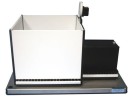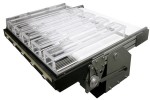Authors
C Guttler, J Altschuler, K Tanev, et al
Lab
Department of Neurology, University Medical Center Gottingen, Gottingen, Germany
Journal
Movement Disorders
Abstract
Background: Levodopa is the most efficacious drug in the symptomatic therapy of motor symptoms in Parkinson's disease (PD); however, long-term treatment is often complicated by troublesome levodopa-induced dyskinesia (LID). Recent evidence suggests that LID might be related to increased cortical gamma oscillations.
Objective: The objective of this study was to test the hypothesis that cortical high-gamma network activity relates to LID in the 6-hydroxydopamine model and to identify new biomarkers for adaptive deep brain stimulation (DBS) therapy in PD.
Methods: We recorded and analyzed primary motor cortex (M1) electrocorticogram data and motor behavior in freely moving 6-OHDA lesioned rats before and during a daily treatment with levodopa for 3 weeks. The results were correlated with the abnormal involuntary movement score (AIMS) and used for generalized linear modeling (GLM).
Results: Levodopa reverted motor impairment, suppressed beta activity, and, with repeated administration, led to a progressive enhancement of LID. Concurrently, we observed a highly significant stepwise amplitude increase in finely tuned gamma (FTG) activity and gamma centroid frequency. Whereas AIMS and FTG reached their maximum after the 4th injection and remained on a stable plateau thereafter, the centroid frequency of the FTG power continued to increase thereafter. Among the analyzed gamma activity parameters, the fraction of longest gamma bursts showed the strongest correlation with AIMS. Using a GLM, it was possible to accurately predict AIMS from cortical recordings.
Conclusions: FTG activity is tightly linked to LID and should be studied as a biomarker for adaptive DBS.
BIOSEB Instruments Used:
Passive avoidance (LE870),Treadmill (BX-TM)

 Pain - Thermal Allodynia / Hyperalgesia
Pain - Thermal Allodynia / Hyperalgesia Pain - Spontaneous Pain - Postural Deficit
Pain - Spontaneous Pain - Postural Deficit Pain - Mechanical Allodynia / Hyperalgesia
Pain - Mechanical Allodynia / Hyperalgesia Learning/Memory - Attention - Addiction
Learning/Memory - Attention - Addiction Physiology & Respiratory Research
Physiology & Respiratory Research
 Pain
Pain Metabolism
Metabolism Motor control
Motor control Neurodegeneration
Neurodegeneration Cross-disciplinary subjects
Cross-disciplinary subjects Muscular system
Muscular system General activity
General activity Mood Disorders
Mood Disorders Other disorders
Other disorders Joints
Joints Central Nervous System (CNS)
Central Nervous System (CNS) Sensory system
Sensory system

